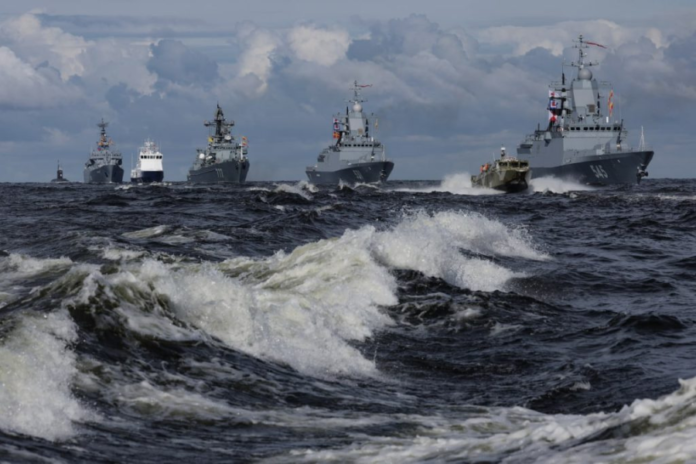According to multiple sources, the navy of Ukraine, the US, and Romania will conduct combined military drills in the Black Sea and the Danube Delta, triggering a possible military standoff with Russia.
From September 11 to September 15, military forces from Turkey, Bulgaria, France, and Great Britain will take part in the naval drills known as “Sea Breeze 23.3.”
The exercises follow Russian attacks on Ukrainian ports around Odessa and the Danube on the Black maritime, which are said to have produced unmanned maritime kamikaze drones used to attack Russian vessels off the Black Sea since last year.
Long-range missiles fired by Russia at the beginning of this month struck drone production facilities, ammunition and fuel storage facilities, and anti-Moscow Russian Volunteer Corps forces, who it refers to as “terrorist sabotage groups” aligned with Ukraine.
On September 9 (Saturday), the Russian Ministry of Defence (RuMoD) said that a second attempt to strike Russian infrastructure farther out in the Black Sea and the Crimean Bridge by speedboat-bound Ukrainian naval special forces and three sea drones had been thwarted.
This occurs at the same time that the UN and Turkey are attempting to relaunch the Black naval Grain Initiative after Russia withdrew on July 17 in response to attacks by naval drones on its vessels.
The agreement, which has been signed by Russia, Turkey, Ukraine, and the UN, permits unhindered grain exports from Black Sea ports by Russia and Ukraine.
Moscow, however, has been emphasising that it was unable to conduct grain commerce as a result of the sanctions, which prohibited it from obtaining insurance for its grain cargo, boats, and the debarment from the Society for Worldwide Interbank Financial Telecommunication (SWIFT) network. The G-20 and the West have been urged by Turkey to comply with this Russian demand.
Vice Admiral Ioan Georgescu, commander of Romania’s Naval Component Command, will oversee the drills, according to a report in Euromaidan Press. The operations would “develop operational and tactical interoperability among the participating nations, particularly in countering explosive hazards such as maritime mines to ensure freedom of navigation.”
Along with the high-speed dive ship Venus, the armoured boat Posada, three amphibious armoured personnel vehicles, attack boats, and other navy vessels, the Romanian dredger Sublocotenent Alexandru Axente will take part. Additionally, it will send marine infantry specialists and experts in the destruction of explosive ordnance.
US divers-engineers with boats and specialised equipment will be sent, along with the Poseidon maritime patrol and reconnaissance aircraft. According to the source, “other participating countries will contribute divers, experts in explosive ordnance disposal, and senior officers.”
The decision to conduct the exercises, according to a TASS report, was made after NATO naval leaders “took place Constanta.” Representatives from the UK, US, Ukraine, France, Bulgaria, Romania, and Turkey were present. It did not, however, state the time or site of the meeting.
Russia retaliates
On September 9 (Saturday), the RuMoD said that Ukrainian sea kamikaze drones attempted to target the Crimean Bridge but were stopped by its fleet. The RuMoD reported on its Telegram channel that “ships of the Black Sea Fleet while on combat duty in the southern part of the Kerch Strait have detected and destroyed three Ukrainian unmanned semi-submersible boats trying to attack the Crimean bridge.”
Additionally, it stated that “50 Ukrainian servicemen” from its “special operations forces” were killed by “Naval Aviation Aircraft” when they were aboard “four high-speed boats…in the waters of the Black Sea west of the Crimean peninsula.”
This follows three Ukrainian efforts on August 31 to seize the Zmeiny island and a Russian oil rig in the Black Sea, which resulted in the destruction of six Ukrainian speed boats carrying special operations personnel and the death of over 50 men. On August 21, Ukraine attempted a similar action.
In this attack, a MiG-29 and a Russian Su-30SM aircraft’strafed’ the boats with its onboard weapons, and the MiG-29’s Heads-Up Display (HUD) displayed the firing of its 30-mm GSh-301 cannon at the targets.
Russia bombs Ukraine ports
Early on Saturday, a RuMoD bulletin noted that “between September 2 and September 9,” it “carried out six group strikes against Ukrainian radio-technical reconnaissance facilities, port infrastructure with high-precision long-range sea- and air-based armament and unmanned aerial vehicles.”
The factories created “manned boats, ammunition, Western weapons, fuel depots, and training bases for AFU sabotage groups and terrorists from the so-called “Russian Volunteer Corps,” according to the report.
Prior to that, on September 3, it issued a particular bulletin regarding the launch of unmanned aerial vehicles (UAV) “against liquid gasoline storage facilities used to supply AFU military assets in the port of Reni (area of Odessa).” The attack “neutralised all assigned targets” and “(reached) its goal” successfully.
Various comments on prominent Russian Telegram groups have come to the conclusion that Russia chose to extend the naval conflict to territory held by Ukraine after initially refraining from striking it, which prompted the US to publicly back Ukraine.



